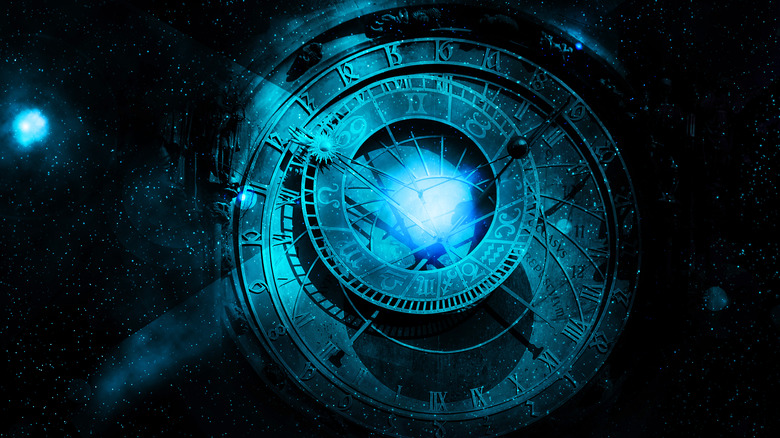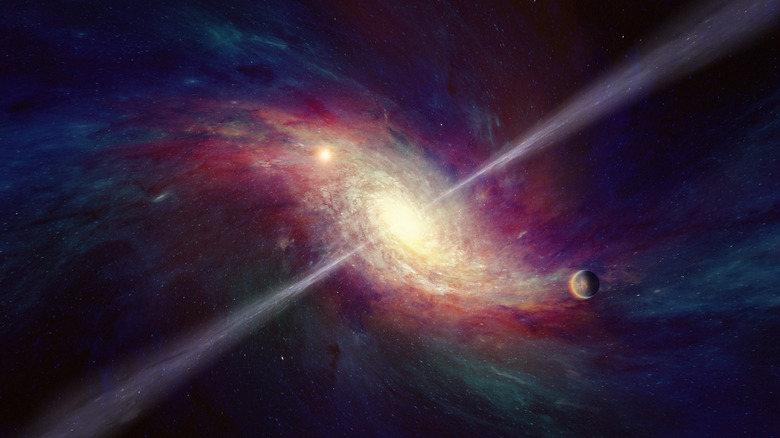How Scientists Proved The Early Universe Ran In Slow Motion
Albert Einstein may not have invented the universe itself, but the fundamental rules he discovered did reinvent our understanding of the natural world, upending convention and defying human experience. Black holes, an expanding universe, the twin paradox, and even the merging of space and time into a single, measurable unit — spacetime — are all a part of his legacy. And according to new research published in the scientific journal Nature Astronomy, the hits just keep on coming.
Researchers from Australia and New Zealand teamed up to verify one of the strangest predictions of Einstein's formulas: that the early universe ran in slow motion compared to today. Because the universe is expanding and there is a limit to how fast light can travel — namely lightspeed — objects that appear farther away also appear as they were long ago. Some of the most distant and most ancient objects in the observable universe today are quasars.
What are quasars?
The word quasar is actually an abbreviation made from the term "quasi-stellar radio sources." They were first discovered as points in the sky that emitted radio waves instead of visible light, hence their "quasi-stellar" nature. Since then, quasars have been found that emit other frequencies of light such as x-rays, but the word quasar stuck anyway. (Quaxar isn't a word, regrettably.) Upon further observation through the second half of the 20th century, it was determined that these point-like objects were actually further away, much larger, and far more powerful than any star in this galaxy or any other.
It's common for galaxies, including our own, to have a supermassive black hole at their center. (They help us find hidden black holes.) In the early universe, space was more densely packed with gases like hydrogen and helium than we observe today. This readily available gas would be drawn to these early black holes and fall toward them at increasing speeds in a superheated spiral called an accretion disk. A quasar is a supermassive black hole with an extremely dense and energetic accretion disk.
The energy of a quasar's infalling matter is so great that powerful magnetic fields form. Some of the matter enters the black hole, but much of it is launched away from the quasar's poles, following the magnetic fields like a particle accelerator but trillions of times bigger. These unbelievably energetic jets are what we can observe today from billions of lightyears away, outshining their entire host galaxies.
Quasars can be clocks
In their new research, scientists detailed how they looked at 20 years' worth of observations of close to 200 individual quasars. The data contained information about how each quasar's energy jets fluctuated over time. They used these periodic fluctuations to measure the passage of time, just in the same manner as watching the second-hand if these quasars were very old and distant clocks.
What the researchers found was that each "second" on the quasar clocks was much slower than what we would observe here on Earth today. And not just by a little bit, it was five times slower. The universe is about 13.7 billion years old right now, but the quasars in this experiment — because they're so far away — appear as if they were just 1 billion years after the big bang. This shows that in the early universe, time passed more slowly.
Of course, one of Albert Einstein's great achievements was showing that time is relative. If you could visit one of these quasars more than 12 billion years ago, you wouldn't notice anything strange about the flow of time — it would feel normal. It's only slow compared to the flow of time today. So, what does it all mean? It means the universe is in fact expanding, and stretching spacetime with it, just as predicted. Einstein was proven right, once again.


